In the UK and beyond, big brands are displaying their organic credentials, but Architectural Consultants Specialising In The Green Belt companies are urging for a move past agenda-less spin.
Inappropriate development is, by definition, harmful to the Green Belt. It is for the applicant to show why permission should be granted. Very special circumstances to justify inappropriate development will not exist unless the harm by reason of inappropriateness, and any other harm, is clearly outweighed by other considerations. Architects have the opportunity to reimagine timber construction and use natural materials in new and inventive ways, liberating the construction industry from its reliance on concrete. General planning needs, such as the need for ordinary housing (as opposed to affordable, social or retirement housing), industrial or commercial development, are not precluded from the green belt exceptional circumstances test and exceptional circumstances should be considered as a whole and in context. It’s important for sustainable buildings to find ways to reduce their energy load, and at the same time increase their energy efficiency and maximise the use of renewable energy. As climate change policy continues to evolve, more and more buildings are beginning to navigate turns operating at net-zero, as a pledge to significantly reduce their dependence on fossil fuels. The creative vision of architects of buildings for the green belt, their experience, and established industry relationships help them navigate the complexities of construction. It is regularly argued that Green Belt restricts the building of the homes we need. But as we have shown here, developments in the Green Belt continue to be land-hungry, and lack the affordable housing that people actually need. At the same time, we are faced with a new way of calculating housing need which will only increase the pressure faced by local authorities to build on Green Belt land.

Green belt architects have experience across all RIBA Stages in multiple types and scales of projects, construction methods, contract types and procurement routes. The NPPF state quite clearly that there needs to be exceptional circumstances for green belt developnment to happen. It could be that there is an elevated demand for new homes, but councils need to demonstrate that every other avenue has been explored first. They need to prove they have exhausted all possibility of using Brownfield sites, that density in current builds has been optimised and that they have considered the needs of neighbouring councils. Designers of homes for the green belt are each passionate about collaborating with homeowners to create properties that support biodiversity, minimise energy usage, and improve air quality. Creating environments that are low carbon and enhance human health and provide joy are essential to the work of green belt architects. They equip their teams with the early stage knowledge needed to lock best practice into every project. Clever design involving Net Zero Architect is like negotiating a maze.
Development On Green Belt Land
Representing the overarching framework for development, a green belt architect's master planning experience encompasses a variety of projects of varying scale, character and purpose across the UK and overseas. Inappropriate development should not be granted planning permission except in very exceptional circumstances where other considerations clearly outweigh the harm which such development would do to the Green Belt or green wedge. Green Belt and green wedge policies in development plans should ensure that any applications for inappropriate development would not be in accord with the plan. Net Zero Energy Buildings can improve or maintain your competitive advantage, improve the value of the property, mitigate market risk, and promote the health and wellbeing of occupants. Architects that design for the green belt design houses that are unique to their location and use. They listen to their clients, to hear how they wish to inhabit their home, and develop their design accordingly. Architects of green belt buildings seek to use their voice to promote their values - using their platforms to challenge the status quo and influence on social and environmental matters. Maximising potential for Architect London isn't the same as meeting client requirements and expectations.
Green belts have a presumption against development and thus little incentive to be positively managed for environmental, community or economic purposes. This leads to degraded landscapes that, while having a valid planning function, produce limited benefit to communities and the environment – unless of course you are lucky enough to live in or next to one. If the debate is centred on the Green Belt then there may also be an argument for Green Belts to be properly planned by a single planning body - or preferably by a regional body that also incorporates metropolitan areas. Green belt planners and architects strive to find the balance between the financial constraints of a project and the potential to explore creative design solutions towards the goal of a more sustainable environment. Many villages are within the Green Belt in which new development is not normally appropriate. However, such villages may contain suitable sites for infill development which would not have an adverse effect on the character of the village or on the open character of the Green Belt. Some projects of green belt planners and architects are subtle but show a strong vision. They can be especially focused on residential projects that strengthen and energize their inhabitants. A well-thought-out strategy appertaining to Green Belt Land can offer leaps and bounds in improvements.
Design Review And Validation
Sustainable architects are designing with circularity at the forefront of their thinking, to make a building that can be adapted for future uses, where components and materials can continue their journey in the building cycle. Building on the green belt is one of the most divisive issues in UK planning law and paragraph 136 of the NPPF is clear that: "Green belt boundaries should only be altered where exceptional circumstances are fully evidenced and justified." The general policy of green belt architects, and something they pride themselves on, is providing quality design solutions to be sympathetic to the local vernacular and environment using colours and material with a commitment to energy efficient and sustainable buildings. Planning permission in the green belt will not usually be granted for development on land that is used, or was last used, as open space. This includes: Parks and Gardens, including Country Parks; Natural and Semi-Natural Green Space; Amenity Green Space; Play Provision for Children and Young People; and Outdoor Sport Facilities, including School Playing Fields. While there is general agreement that an acute housing shortage exists, particularly in London and the South East, there is disagreement over whether compact city models that focus on ‘brownfield’ land can provide sufficient developable land. Can Green Belt Planning Loopholes solve the problems that are inherent in this situation?
By making it a priority to purchase steel, lumber, concrete, and finishing materials, such as carpet and furnishings, from companies that use environmentally responsible manufacturing techniques or recycled materials, green belt architects up the ante on sustainability. Green Belt boundaries should be drawn so that they endure, and will not need to be altered at the end of the plan period. This normally means that land is excluded which it is not necessary to keep permanently open, even if there is no known intention or need to develop the land in the foreseeable future. Certain factions within Parliament understand the pressing need for freeing up Green Belt land, particularly those areas that are a mere 45 minutes away from London and just a 10-minute walk from the train stations. Proposals for the conversion of buildings to residential use will be treated with particular caution as they can often have an unacceptably detrimental effect on both the character of the building and on the surrounding countryside (particularly through the creation of a residential curtilage). This is particularly the case with isolated buildings in the open countryside, and hence in appropriate circumstances, the Council will withdraw residential permitted development rights from rural buildings when granting planning permission for residential conversion. In this rapidly changing world, the connection between people and nature is being considered, and design holds the key. Green belt architects strive to enhance the connection between natural and built environments, taking into account practical, aesthetic, and environmental sustainability as central components of any design. Local characteristics and site contex about New Forest National Park Planning helps maximise success for developers.
Planning Permission On The Green Belt
As a practice green belt architects are committed to developing, supporting and encouraging education, diversity and equality in their professions. Their Architect’s share their knowledge and experience as RIBA mentors to their students and show how the responsibilities of an Architect can shape everyone’s lives. New dwellings in green belt areas should reflect the traditional scale of the vernacular buildings. Proposals should avoid sprawling layouts that are more appropriate to urban and suburban areas, and which could adversly affect the open, un-developed nature of the countryside. Land is a finite resource and those seeking to achieve the most beneficial use of their land/buildings, need to ensure that proposals for development are promoted in the most effective manner based on solid planning advice. You can get supplementary details on the topic of Architectural Consultants Specialising In The Green Belt on this House of Commons Library link.
Related Articles:
Background Findings With Regard To Green Belt Architectural Companies
Background Insight With Regard To Green Belt Consultants
Additional Findings On Green Belt Planning Consultants
Supplementary Information On London Green Belt Architects
More Background Insight On Green Belt Architectural Companies
Extra Insight About Green Belt Planning Consultants
Further Findings With Regard To Architects Specialising In The Green Belt


